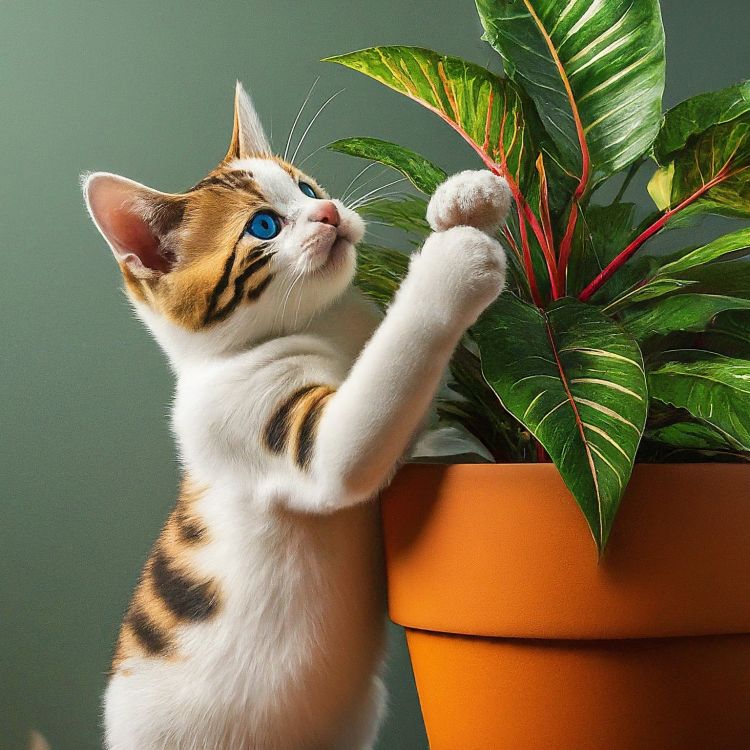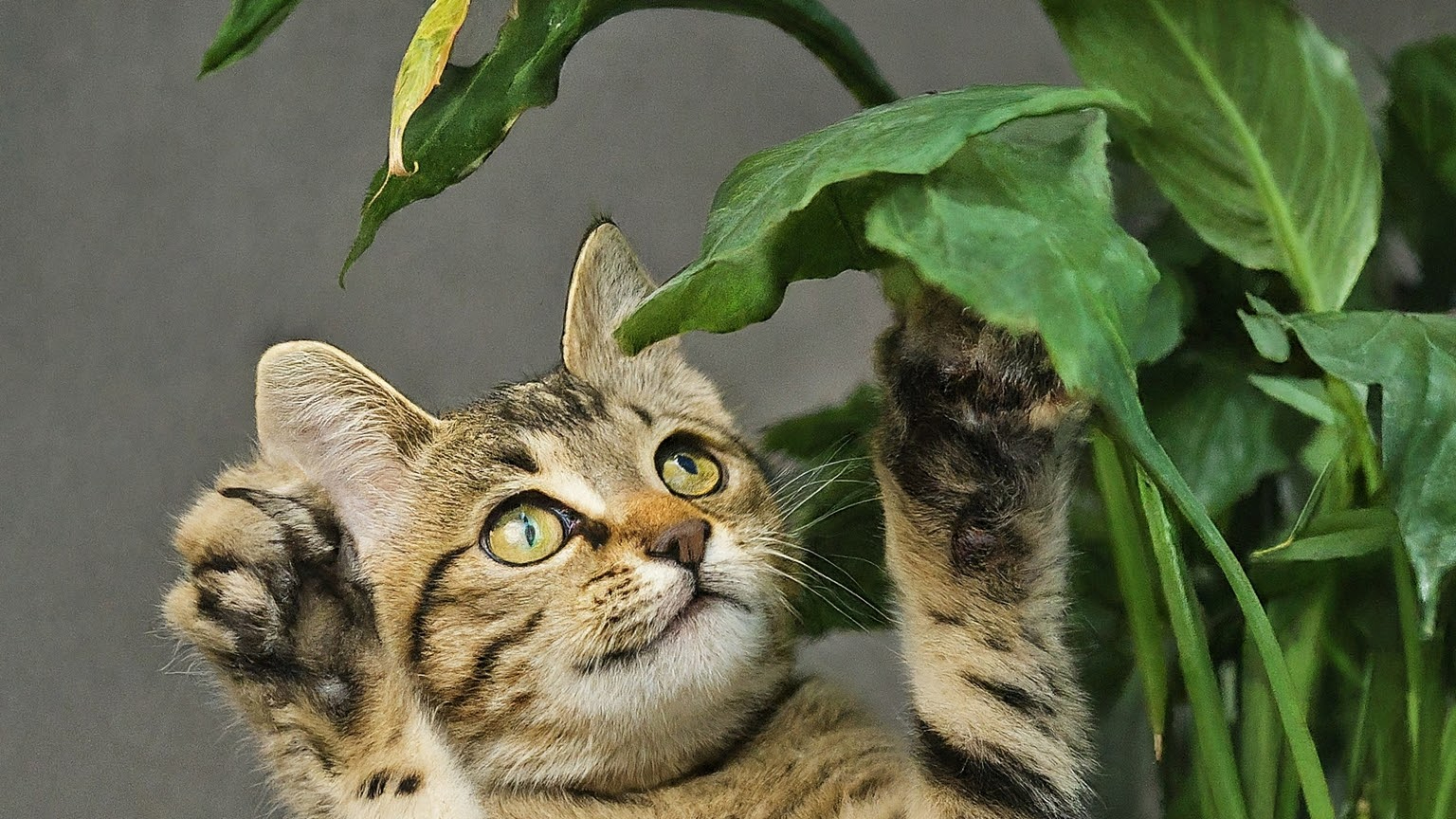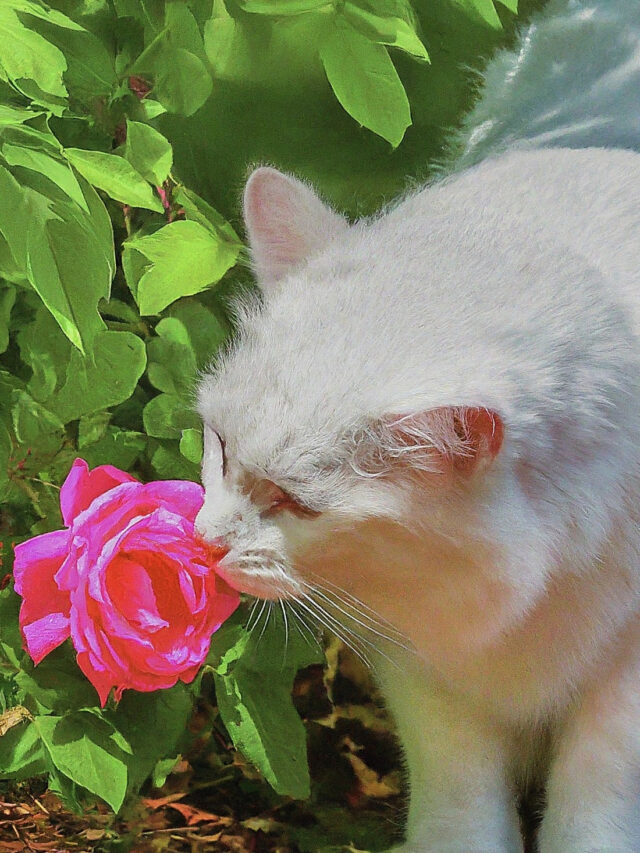Cats are renowned for their curious nature, often turning household objects, including plants, into potential prey or playgrounds. However, this natural behavior can leave your cherished greenery looking worse for wear, with leaves nibbled, fronds torn, or soil used as a makeshift litter box. While it might seem like a never-ending battle to maintain your indoor jungle, understanding why your cat is drawn to your plants is crucial. Fear not, as there are numerous helpful strategies for keeping cats away from your plants without resorting to harmful methods. Here are some effective techniques on how to keep cats away from plants:
Contents
- 1 12 Tips For How to Keep Cats Away from Plants in a Web Story
- 2 How to Keep Cats Away From Plants: 12 Easy Techniques
- 2.1 Choose Cat-Friendly Plants
- 2.2 Provide Alternative Scratching Surfaces
- 2.3 Cover the Soil
- 2.4 Use Scent Deterrents
- 2.5 Utilize Commercial Repellents
- 2.6 Train Your Cat
- 2.7 Provide Distractions
- 2.8 Create Safe Outdoor Spaces
- 2.9 Consult a Veterinarian
- 2.10 Use Motion-Activated Devices
- 2.11 Create Physical Barriers
- 2.12 Adjust Your Plant Placement
- 3 Why Is My Cat Eating My Plants?
- 4 FAQs
- 5 Strategies for How to Keep Cats Away from Plants
- 6 Author
12 Tips For How to Keep Cats Away from Plants in a Web Story
Seeking visual delight? Explore our web story that’s packed with easy and simple tips!
Simply swipe left or right to navigate.
How to Keep Cats Away From Plants: 12 Easy Techniques
Let’s explore 12 easy and simple techniques for how to keep cats away from plants.
Choose Cat-Friendly Plants
Choose plants that are less likely to attract your cat’s attention as a proactive measure for how to keep cats away from plants. While no plant is entirely cat-proof, selecting cat-friendly options can significantly reduce the likelihood of your feline friend taking an interest. Consider incorporating spider plants, ferns, and palms into your indoor greenery collection, as these species are generally less appealing to cats when compared to plants like catnip or grasses. By strategically choosing plants that are less enticing to cats, you can reduce the risk of your furry friends causing mischief in your botanical haven.
Provide Alternative Scratching Surfaces
Cats love to scratch, and sometimes they might choose your plants as their scratching post. To help them find a better place to scratch, give them scratching posts or pads, these are very helpful when trying how to keep cats away from plants. Put these near your plants, so your cat can satisfy its scratching urge without damaging your greenery. This way, you can keep your plants safe and your cat happy.
Cover the Soil
Cats are attracted to the soil for various reasons, including using it as a litter box or simply enjoying the texture. To deter your cat from digging in your plant’s soil, consider covering the surface with decorative rocks or pine cones. These obstacles make it less accessible and less appealing for your cat to dig. Additionally, you can try placing aluminum foil or double-sided tape over the soil. The unfamiliar texture can discourage digging behavior, helping to keep your plants safe from curious paws.
Use Scent Deterrents
Cats have a keen sense of smell, which can be utilized when thinking about how to keep cats away from plants. Certain scents, such as citrus, lavender, or eucalyptus, are known to be unpleasant to cats. Take advantage of this by sprinkling citrus peels or placing cotton balls soaked in essential oils around your plants. These scent deterrents create a barrier that cats find unpleasant, discouraging them from approaching your plants. However, ensure that the scents you choose are safe for cats if ingested, to avoid any harm to your pet.
Utilize Commercial Repellents
Commercial cat repellents offer a convenient solution to keep away cats from your plants. These products often utilize natural ingredients like pepper, garlic, or citronella, which are unpleasant to cats. By following the instructions carefully, you can effectively apply these repellents around your plants to create a deterrent barrier. It’s essential to ensure that the products you choose are safe for both your plants and your pets, as some ingredients may be harmful if ingested.
Train Your Cat
Consistent training is key to teaching your cat to stay away from your plants. Using verbal cues or gentle deterrents like a spray bottle filled with water can help reinforce boundaries and discourage undesirable behavior. With patience and persistence, your cat will learn that certain areas, including your plants, are off-limits. Consistent training fosters a harmonious environment where both your plants and your pet can coexist peacefully.
Provide Distractions
Keeping your cat mentally and physically stimulated is crucial for preventing boredom-induced mischief. Provide a variety of toys and engage in regular playtime sessions to keep your cat entertained and engaged. A well-entertained cat is less likely to turn to your plants for amusement, reducing the risk of damage to your greenery. By prioritizing your cat’s enrichment needs, you can minimize their interest in your plants and promote their overall well-being.
Create Safe Outdoor Spaces
How to keep cats away from plants? And the simple answer is to create safe outdoor spaces. If your cat likes being outside, make a special area for them to play and explore. This outdoor space can distract them from your indoor plants. By giving them a fun place to hang out, you can keep them away from your greenery.
Consult a Veterinarian
If despite your efforts, your cat’s plant-chewing behavior persists, it may be beneficial to consult with a veterinarian or animal behaviorist. There could be underlying medical or behavioral issues contributing to their behavior, which require professional assessment and intervention. A veterinarian can provide valuable insights and guidance tailored to your cat’s specific needs, helping to address the root cause of their behavior and promote a harmonious relationship between your pet and your plants.
Use Motion-Activated Devices
Consider utilizing motion-activated devices, such as ultrasonic deterrents or compressed air sprays, to discourage cats from approaching your plants. These devices emit a sound or burst of air when triggered by motion, startling cats and deterring them from getting too close to your greenery. Place these devices strategically near your plants to create an effective deterrent zone, helping to keep cats at bay without causing them harm.
Create Physical Barriers
Construct physical barriers around your plants is a simple answer for how to keep cats away from plants. Use chicken wire, lattice, or plastic mesh to create protective enclosures around your planters or garden beds. These barriers make it difficult for cats to reach your plants, reducing the likelihood of damage caused by their curious exploration. Additionally, you can place upside-down carpet runners or prickly textures like pinecones or rough stones around your plants to create uncomfortable surfaces that deter cats from venturing too close.
Adjust Your Plant Placement
Evaluate the placement of your plants and consider rearranging them to make them less accessible to cats. Place tall plants on high shelves or hanging baskets out of reach of your feline friend. Alternatively, create vertical gardens or green walls to maximize space while keeping your plants safely out of reach. By strategically positioning your plants in areas that are less accessible to cats, you can minimize the temptation for them to explore and interact with your greenery, reducing the risk of damage to your plants and promoting a harmonious living environment.
Why Is My Cat Eating My Plants?

Taste Preference
Cats like to taste things they find interesting, similar to how babies explore with their mouths. Even if we don’t enjoy the taste of plants, cats might think they’re yummy and want to eat them.
Safety Concerns
Ensuring your indoor plants are non-toxic to your furry friend is essential for their safety. However, even non-toxic plants can lead to stomach upset or gastrointestinal blockages if ingested. Additionally, cats may experience gagging or vomiting if plant material becomes lodged in their throat due to the tiny backward-facing hooks, called papillae, on their tongues.
Watch for Signs
If you observe any unusual behavior in your cat, such as vomiting, increased water consumption, drooling, or changes in eating habits or litter box behavior, it’s crucial to seek veterinary assistance promptly.
Texture Fascination
Cats may also be drawn to the texture of plants, such as grass, particularly if they have an upset stomach and instinctively seek fiber to aid digestion. Some cats may even nibble on grass to induce vomiting, potentially to alleviate discomfort from hairballs, although this behavior’s exact purpose remains uncertain.
Attraction to Movement
Cats love to hunt, and when they see leaves or plants moving, it makes them excited to pounce, just like when they hunt for prey. Some plants, like the Spider Plant, with their swaying leaves, can attract cats. But it’s important to make sure cats don’t eat them because even plants that aren’t toxic can be bad for them if swallowed.
Boredom Buster
Furthermore, cats may resort to chewing on plants out of boredom. Despite their reputation for independence, cats require mental and physical stimulation to prevent destructive behaviors. Neglecting to provide adequate enrichment may lead cats to seek out alternative forms of amusement, which can include chewing on household plants.
FAQs
Are there certain plants that are safe for cats?
Yes, several cat-friendly plants are safe for your furry friends to be around. Examples include spider plants, ferns, and palms. However, it’s always essential to research specific plants to ensure they are non-toxic to cats.
How can I deter my cat from chewing on my plants?
There are various strategies you can employ to deter cats from chewing on your plants, such as providing alternative scratching surfaces, covering the soil with decorative rocks or foil, using scent deterrents like citrus or lavender, and utilizing commercial cat repellents.
Is it normal for cats to chew on plants out of boredom?
Yes, cats may resort to chewing on plants out of boredom, especially if they lack mental and physical stimulation. Providing enrichment activities, such as toys, playtime, and access to safe outdoor spaces, can help alleviate boredom and prevent destructive behaviors.
Are motion-activated devices safe for cats?
Yes, motion-activated devices, such as ultrasonic deterrents or compressed air sprays, are generally safe for cats. These devices emit a sound or burst of air when triggered by motion, startling cats and deterring them from approaching your plants without causing them harm.
What should I do if my cat continues to chew on plants despite my efforts?
If your cat’s plant-chewing behavior persists despite your efforts, it’s essential to consult with a veterinarian or animal behaviorist. There may be underlying medical or behavioral issues contributing to their behavior that require professional assessment and intervention. A veterinarian can provide tailored advice and guidance to address the root cause of your cat’s behavior effectively.
Strategies for How to Keep Cats Away from Plants
How to keep cats away from plants to maintain a lush indoor garden while cohabiting with a curious feline companion may seem like a daunting task, but with the right strategies, you can create a harmonious environment where both your plants and your pet thrive.
Understanding the reasons behind your cat’s plant-chewing behavior is the first step towards effectively addressing their needs and safeguarding your greenery. From choosing cat-friendly plants to providing alternative scratching surfaces and utilizing scent deterrents, there are numerous proactive measures you can take to keep cats away from plants.
Additionally, incorporating motion-activated devices, physical barriers, and strategic plant placement can further reinforce boundaries and minimize your cat’s access to your plants.
Consistent training, adequate enrichment, and the creation of safe outdoor spaces offer further opportunities to redirect your cat’s energy away from your plants and toward more appropriate activities.
Consulting with a veterinarian or animal behaviorist can provide valuable insights and guidance tailored to your cat’s specific needs, ensuring a harmonious relationship between your pet and your plants. By implementing these effective strategies and maintaining vigilance, you can create a safe and enriching environment for both your beloved plants and your cherished feline companion, fostering a thriving indoor oasis where everyone can coexist happily.


